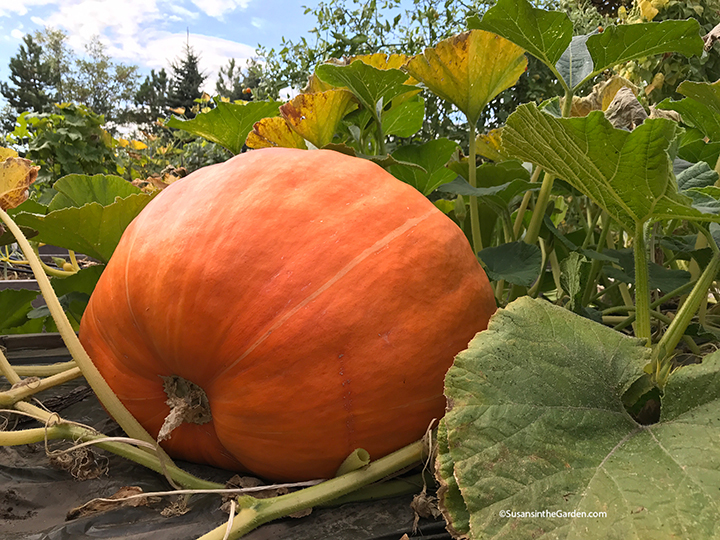How to Grow Pumpkins

No matter what your hardiness zone is, you can still grow pumpkins! There are so many different sizes and types to choose from. Just follow my tips below and you’ll do great.
Latin Name: Cucurbita maxima
Plant Family: Cucurbit (Cucurbitaceae)
Warm-season crop
Did You Know?
Pumpkins are a type of winter squash. All are edible but vary in taste and consistency. There are so many different cultivars available! They range from tiny decorative ones up to whoppers that gardeners grow for bragging rights. It is believed that pumpkins originated in Central America more than 7,500 years ago. That’s a lengthy history of cultivation. They are grown everywhere but Antarctica.
Plant Seeds or Seedlings? Sow seeds directly in the garden or start indoors two weeks prior to transplanting outside.
When: After all danger of frost has passed.
Days to Germination: 7 to 14 days
Depth to Sow: 1 inch. For the best germination results, plant seeds with pointed end facing downward.
Spacing: Sow two to three seeds or seedlings in a mounded planting “hill” or plant them two feet apart.
Days to Maturity: 80 to 110
Cultural Information:
Be aware that pumpkin vines really spread out. You can to take that into account when choosing a spot for them. Prior to planting, prepare their bed by working compost and bonemeal into top 3 inches of soil. After planting the seeds or seedlings, cover bed with floating row cover to create a warm, greenhouse-like environment. Give young plants a nitrogen fertilizer such as diluted fish emulsion. Remove the row cover before they start blooming as pollinators will need access to the flowers. Water regularly as the plants will grow rapidly.
To grow pumpkins in USDA zone 7 and below, here’s my special tip. Once each plant has a pumpkin or two developing on it, trim the vine back to a few inches past the fruit. This causes the plant to use its energy on developing it rather than continuing to bloom and grow leaves.
Are you going to grow giant pumpkins? Remove all but one pumpkin from each plant so it receives all of the moisture and energy it needs to grow large.
Susan’s Picks: ‘Atlantic Giant’ or ‘Big Max’ (for whoppers); ‘Casper’ (white); ‘Jack Be Little’, ‘New England Pie’, ‘Rouge Vif d’Etampes’ (a.k.a. ‘Cinderella’), ‘Spookie’
Potential Insect Problems: pillbugs, cutworms, squash bugs, squash vine borers
When to Harvest:
Do the “thumbnail” test to see if the pumpkin is mature. Press your nail into the skin; if it cuts through it easily, it is not ripe. Let it continue growing. If your nail doesn’t pierce the skin, the pumpkin is ripe. The stem usually turns golden as well, which is also something to look for. When picking, leave 2 to 4 inches of stem attached. That’s because rot can develop in the area where it was connected to the vine. To prepare for storage, “cure” the pumpkin by moving it to a warm area protected from the weather for two weeks. Then you can move it to a cool, dark location for storage. Pumpkins can last anywhere from 2 to 6 months in storage, depending on the type grown and storage conditions. Sugar pumpkins typically last the longest.
How to Cook & Preserve:
In addition to using pumpkin flesh for awesome pies, it can be added to soups, stews and casseroles. It makes great muffins and cookies, too. To roast a pumpkin in the oven, either cook whole (if modest-sized) in 350-degree oven for about 2 hours. Or cut into pieces, place skin side up in a roasting pan with a small amount of water in the bottom. Bake it at 300 degrees for 1 hour or until soft. To preserve pumpkin puree, it must be canned using the pressure-canning method due to its low acidity. You can also freeze pumpkin chunks. Cook them until they’re soft in boiling water or in the oven, then plunging them into ice-cold water. Drain and place chunks into freezer bags.
My Videos About Growing Pumpkins:
- Harvest Winter Squash & Pumpkins
- Winter Squash & Pumpkins: You Grew It, What To Do With It!
- How to Make Homegrown Pumpkin Pie
- Pumpkin-Growing Competition Results
Back to Vegetable Grow Guide Chart
Copyright: Susan Mulvihill, Susan’s in the Garden, SusansintheGarden.com.

